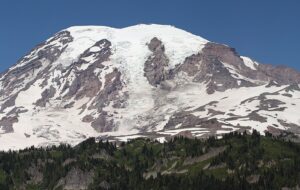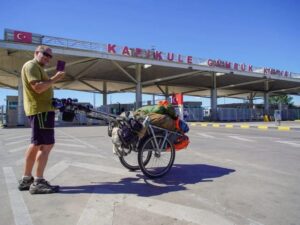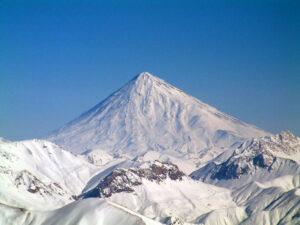BY NABRAJ GHIMIRE
At age 28, Gelje Sherpa has already climbed 11 of the 8,000’ers, including eight as part of Nirmal Purjas’ 2019 blitz of all 14. He is also famous as the youngest of the 10-man Nepali team that summited winter K2 on January 16, 2021.
Gelje climbed Everest in 2018 and again in 2021 as part of an Everest-Lhotse double-header. He now has only Kanchenjunga, Broad Peak, and Cho Oyu to do before he completes the 14×8,000’ers.
If successful, he will become fourth Nepali to do all of them. And if he can do the last three within the next year and a half, he will also become the youngest member of this exclusive club. Mingma David Sherpa, Gelye’s superstar working partner at Elite Exped, currently owns that record.
But Gelje’s story goes beyond records and numbers. It’s a tale of survival and growth through a difficult childhood, a series of mountain tragedies, and one of the most dangerous jobs in the world.
ExplorersWeb had the rare chance to interview one of this younger generation of Super Sherpas shortly before Gelje left to guide on Manaslu.
In his father’s footsteps
What’s your family background?
I was born and raised in the Solukhumbu area with my three siblings. I lost my mother when I was a small child. My father had seasonal work as a porter for Westerners and that is how we made our living.
Because of various obstacles, I couldn’t continue my education after primary school, which I always regret. After that, I started to follow in my father’s footsteps.
At age 14, I went with my father to Mera Peak in the Everest region. I gave climbers warm water below the summit. I got the job by accident. The real cook was sick.
I remember receiving $700 in tips for my work. Those tips were the magnet that drew me to the industry. At 16, I started to work as a porter and later as an assistant guide.
While I was a guide, I got married. My wife’s relatives helped me get a job as an Icefall Doctor. I did it for five years. I enjoyed it for the first few years because I didn’t know anything about the Khumbu Icefall. Later, I discovered how deadly and untrustworthy that place is. I was delighted when I was promoted from Icefall Doctor to 8,000m climbing guide.
The 8,000’ers
Every mountaineer I met asked me if I’d done Everest. I wanted to climb it one day and I started to hunt for an expedition company [to build up my resumé]. In spring 2017, I had the chance to go to Kangchenjunga as a high-altitude guide. We had to turn back at 8,200m because of bad weather.
That autumn, I had a chance to summit Manaslu. It was my first 8,000’er. Later in 2018, I also went to Everest for the first time.

Gelje, with Nepal’s flag on the summit of Ama Dablam.
Why are you heading to Manaslu as a guide rather than focusing on completing the remaining 8,000’ers? You’re in a race to become the youngest to summit them all.
I wish I could do that but I need to earn some money to make my project come true. Because of COVID-19, we have lost most of our income, so to support my family in Kathmandu, I have to work. Rent, my children’s education, and their food are more important than record-setting.

Gelje Sherpa, centre, on his way to Manaslu with the rest of the Elite Exped team.
Kangchenjunga later this fall
What are your plans after Manaslu?
I am planning to climb Kangchenjunga on a commercial climb later this autumn as a climbing Sherpa. I am doing it this way to save money for Cho Oyu and Broad Peak. Money issues are currently keeping me up at night. [Editor’s note: The only commercial climb on Kangchenjunga this fall is Alpenglow’s.]
Currently, the Chinese are not allowing foreign climbers into the country. How do you plan to climb Cho Oyu?
The Nepal/China border has not yet opened. Even the few Chinese who visited the Nepalese mountains last spring are having a hard time returning home because of rising COVID rates in Nepal. I will try to obtain a diplomatic permit through the Ministry of Tourism. If that doesn’t work, I may try from the Nepal side. But there is no official route and I would need at least a dozen Sherpa friends to support me. I am hoping to make this happen in spring or fall 2022.
What about Broad Peak?
Hopefully, that will be in summer 2022.
Once you complete the 14×8,000’ers, and especially if you do get the “youngest” record, how do you think it will affect your life?
This will open new windows of opportunity, and elevate my profile and career from where they are today. It would lead to more publicity and hopefully allow me to form [my own outfitting] company.
It will also help many other Sherpas like me who come from remote corners of Nepal looking for opportunities in Kathmandu. I will work on developing our Sherpa porters and climbers and make an elite team of adventurists while creating employment. In Nepal, I will be a role model for the younger generation and will pursue motivational speaking and social work as well.

Atop Annapurna I, Gelje smiles behind his client’s selfie. Photo: Gelje Sherpa/IG
Vocation, not avocation
If money were no issue, would you still work in high-altitude mountains?
I have to speak the truth: Definitely not! I’ve been doing this hard job mainly to earn a living. It’s also true that after climbing all these mountains, part of me has fallen in love with them and I couldn’t just walk away. My life will continue to evolve, but the mountains will always be part of that.
But I can’t say how important these mountains will be to my children’s generation. I hope they have the chance to enjoy other meaningful but less strenuous careers. It is not necessarily my goal for my children to follow in their father’s footsteps.
Is there one mountain you got a lot of personal pleasure out of climbing?
Nanga Parbat. It’s a killer mountain, but the views are great and its climbing history is so memorable. The loss of Sherpas on Nanga Parbat while climbing for the Germans [in 1934] makes me proud to be a Sherpa. They died together with their employers and didn’t run away from the problems.
And from the top of Nanga Parbat, you can see the beautiful villages, greenery, roads, temples, and valleys all the way down. I have always found this in stark contrast with the summit of Everest, where all you can see is layers and layers of mountains.

Gelje Sherpa, “kissed” by K2, as he called it, after his winter summit and a non-stop descent back to Base Camp. Photo: Gelje Sherpa
Winter K2
How do you remember the day that you were on the summit of K2 with the other nine Nepalis? What was it like, how did each section feel, the arrival at the summit…?
I first went to winter K2 in 2018-19 with Alex Txikon. We reached near Camp 3, so I already had some idea about K2 in winter. In 2021, we decided at the last minute to go to K2 because we realized that summiting it in winter was going to be a race among mountaineers.
We were pretty confident in our ability to attack it collectively under the leadership of Nirmal Purja. We joined forces with Mingma G’s team and also with Sona Sherpa’s Seven Summit Treks’ group. This made 10 of us, which gave us even more confidence that we could solve this great problem in high-altitude mountaineering.
But passing through the Bottleneck was not easy. The blue ice was so thick and strong. Around 100 to 120m of it was so hard that my crampon teeth could barely go half an inch deep. I was tired, and it was so cold.

Summit of winter K2, with Mingma David, left, and Gelje. Gelje was the youngest on the team but also one of the most experienced, thanks to his previous winter attempt with Alex Txikon. Photo: Gelje Sherpa
On the summit day, we kept 10 to 12 minutes maximum between climbers, since it was not ideal to wait longer for each other and get frostbite. Our team reached the top together and sang the Nepalese anthem, which brought tears to my eyes.
After the summit, I rushed back to Base Camp with Sona, since sleeping with frostbitten cheeks wasn’t the best idea. Nirmal Purja was concerned about my safety on the way down, but I assured him as well as I could.
Teamwork was the best part of our success and one of the things that we Sherpas take pride in. Although we normally climb as guides and porters for Westerners, this time we climbed on our own, as climbers. This record is for Nepal and will always make Nepal and Nepalese proud.
The day we returned to Kathmandu, we went to a formal event at our Prime Minster’s residence. The welcome and love we received from the Nepalese people will always make this one of the most memorable days of my life.
In Pakistan, we also met their Army General and their President Dr. Arif Alvi at his residence. It was a beautiful part of the K2 story which I won’t forget.
Triumph and tragedy
Sadly, the tragic loss of Ali Sadpara, John Snorri, and Juan Pablo Mohr soon overshadowed your team’s amazing success. Any comments?
While coming down from the summit, I gave Ali Sadpara my first-hand impressions. I said that his team had fewer people and it could be very difficult for Ali’s team to attack K2. But he might have thought to himself, Why can’t I make it when you little Sherpas can?
This led to the bitter experience of losing him. I will always remember that I had tried him to stop but failed.
It was a very hard time for us: At the same time that we were celebrating in Kathmandu, Pakistan was losing its hero and was in pain and sorrow. We didn’t know whether to laugh or cry.
There were also rumors that the Nepalese cut the fixed ropes, which was just false. We had no time to think of anything other than returning safely to camp. We are a Buddhist people, and our karma does not allow us to do such things. That was a huge public underestimation of Sherpa ethics. We have supported generations of Westerners and proved our loyalty and honesty.
Hard times
How are you doing in these difficult times for mountain tourism because of COVID?
We are living a basic life from small savings that came from winter K2 and other expeditions. COVID has hit my family hard, but who should I tell this to? Nepal’s government? Tourism organizations?
At the end of the day, you climb the mountain yourself, so I also have to manage this on my own. The government in Nepal does not understand the hard work that we do for our country. There is no support in this hard time for any tourism worker.
This doesn’t make climbers happy. Sadly, some are leaving Nepal for life in other developed countries. If I didn’t have some small savings, I can imagine how hard it would be financially for me.

What Gelje considers the most reliable gadget for staying connected on Everest: an old cellphone. Photo: Gelje Sherpa
Sherpas use supplemental oxygen while guiding because they are at work. But if they were climbing for “fun”, they could do some amazing alpine-style climbs. What do you think about this?
It is already clear that Sherpas do not necessarily need as much oxygen as their clients. Just look at the records of Ang Rita Sherpa, Babu Chhiri Sherpa, or Nirmal Purja. We are born and raised where less oxygen is present in the air we breathe daily. But for the safety of our clients, we climb with oxygen. As a joke, we call it English air.
No Sherpa wife wants her loved one to climb
What does your family think about your profession?
My wife doesn’t want me to go to the mountains, she says I should find other opportunities. She knows that mountaineering is not an easy game and how hard the work is. She sees this from my pictures or from the news about some Sherpa’s accident. It happens often.
Every Sherpa spouse knows how much losing someone affects the whole family. If you look at history, even Ang Lambu, the wife of Tenzing Norgay, wanted to stop him from joining the 1953 British expedition. They had an argument in their home in Darjeeling. But in the end, Ang Lambu had no option but to let him go. I guess no Sherpa wife is happy to send her loved one to the mountains.
When I go climbing, my wife does special prayers in our home and lights prayer candles for my safety. Sometimes she buys a captive fish and frees it in the river for my sake or releases pigeons in temples.

Gelje climbed eight of his 8,000m peaks with Nirmal Purja, left, on the summit of Gasherbrum II. Photo: Elite Exped
Meeting Nirmal Purja
How did you meet Nirmal Purja ?
In spring 2019 on Annapurna, I was part of a Seven Summit Treks team and first met Nirmal Purja. I was considered a possible teammate on Nirmal Purja’s project and went to Dhaulagiri directly from Annapurna. Dhaulagiri was the mountain I always wanted to climb, so I asked Purja if I could join his team. He said yes. That was the beginning of my real race with the 8,000’ers. After that, we went to Makalu, and after Makalu, we went to Pakistan. I have earned my family’s livelihood through his company for several years.
The Khumbu collapse and the earthquake
Have you had many close calls in the mountains?
On April 18, 2014, I was just half an hour away when that avalanche killed 16 Sherpas in the Khumbu Icefall. That year, I was working as an Icefall Doctor. After the accident, I worked on the rescue and management of the dead bodies.
Then on April 25, 2015, again on Everest, a 7.8 earthquake struck Nepal. I saved myself from the avalanche that came from Pumori into Base Camp by hiding under the dining table in camp. At least 22 people died that year also. The avalanche gave me a mild head injury, but I was lucky to be alive. There were dozens of dead bodies beside me.
Once on Dhaulagiri, we went down overnight from the summit to base camp. The whole thing was in the dark, and I accidentally clipped into an old rope. But I was still clipped into a new one, which saved me [when the old rope broke]. At night, it’s hard to identify the old ropes, as they all look pretty similar in snow.
Till this day, God has looked after me very well, but you can’t trust mountains.
The quest
Do you think you can break the record of your friend Mingma David, who climbed the 14 8,000’ers by age 30 years and 166 days?
I wish I could, but I am still looking for sponsorship. Finances are my problem because I am just a Sherpa climber. Also getting a permit for Cho Oyu from China will be complicated.
Currently, I am 28 years and 10 months old, which means I have more than a year and a half to break this record. If things go well, I am pretty confident I can manage it.

Heading past Lobuche en route to Everest. Photo: Gelje Sherpa
ABOUT THE AUTHOR
Nabraj Ghimire is from Kathmandu, Nepal. He is an entrepreneur and freelance journalist specializing in travel. He holds Bachelor’s and Master’s Degrees in Humanities and Social Science and is the owner of a trekking agency and a guest house in Nepal’s capital.






